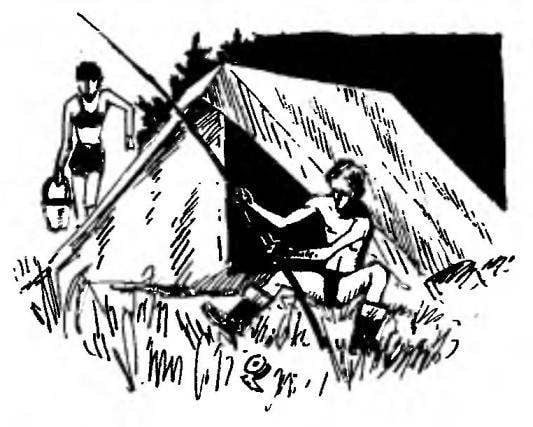Preparing the fabric the ends of the tent should be cut on the machine their edges, and the input end sew two plastic fasteners-zippers snaps in different directions. If desired, the ends sewn window made of nylon mesh with the closing of valves and pockets for small things.
Blank visors cut from the same plastic film that the floor and roof. At their outer lower corners of the segments sewn nylon lace (stretch) for attaching canopies to the ground pins, and the outside edges strengthened with tape.
Prepared parts and components of the tent are connected in the following sequence. First patch seams floor is sewn to the bottom of the roof and nylon braid, previously sewn to the edge of the roof, and then sewn the ends. Last prostrachivajut also overlaps the floor. The joints ends with floor and roof in the corners of the tents are sewed manually with a trial formulation of the tent.
Visors nastraivatsa on the front edge of the roof, and the seams are pasted on the outer side of adhesive tape. Before connecting parts canopies continue the ridge of the braid (stretching) preferably be set so that they are then fastened to the ground at an angle of 45°, and baste a line of stitching peaks. After stitching parts of the seams and the “free” edges of the visors pasted tape over it.
At trial the statement of tent it is necessary to clarify the location holes for the pins stretching the floor. They must match the holes in the braces of the roof so that each pin is well pulled and held and the floor and the roof. In the future, after a good fit, for ease of setting up tents stretching the floor and roof should be to sew in pairs.
Iarf tents in the illustrated embodiment, does not exceed 1.5 kg. Of which slightly more than 700 g “pulls” plastic film (10.5 mg, with weight of 70 g/mg). The cotton ends of the 5.5 m2 of the same fabric depending on the thickness of the material weigh 300-500 g. the Remaining mass is composed of adhesive tape, nylon braid and “lightning”
If the transparent film of the roof of the tent is duplicated gauze (40 g/mg), the tent is heavier still at 250 grams. Studs with a length of 150 mm are best made from steel wire with a diameter of 3 mm. Along with two duralumin pegs, they “pull” about the same as the gauze.
The tent is put in the following sequence. First crushes and strengthened floor six pins (in pairs on each side). Then up onto the roof racks and with the help of two pegs on the opposite ends are stretched the ridge of stretch marks. The latest in a tense position prishpilivayut to the ground the visors.
The constructive scheme of the tent allows you to easily change its size. You only need to slightly increase or decrease the figures of the length of the floor and roof (1900 mm) to the right. For the better protection of the ends of the tents from the “squint” of rain with wind can be increased and the peaks, taking into account the ease of entry and exit.
Using a tent in various campaigns, we are convinced enough of its reliability. It should be noted that the strength of this plastic film is not so small as it seems at first glance. For clarity, we can remember as young fishermen carry fish in a package filled with several liters of water: because the strength of the polyethylene of 150 kg/cm2. This means that the ribbon film of a width of 10 mm can withstand a load up to 1 kg (normal film thickness 0,06—0,08 mm). However, it should be remembered that the film is easily pierced and cut by sharp objects. In this case it is necessary to have a for urgent repair of the coil tape.
N. IVANOV, Saint-Petersburg
 Sold in stores in the domestic tent with awning heavy (about 3 kg), and without an awning — do not protect from the rain. Import — easier and better, but expensive. Therefore, some tourists do make tents of fine nylon is in combination with a tent made of waterproof material. However, the awning complicates the design of the tent, weight it and increases the “breaking down”, and the total value remains high.
Sold in stores in the domestic tent with awning heavy (about 3 kg), and without an awning — do not protect from the rain. Import — easier and better, but expensive. Therefore, some tourists do make tents of fine nylon is in combination with a tent made of waterproof material. However, the awning complicates the design of the tent, weight it and increases the “breaking down”, and the total value remains high.